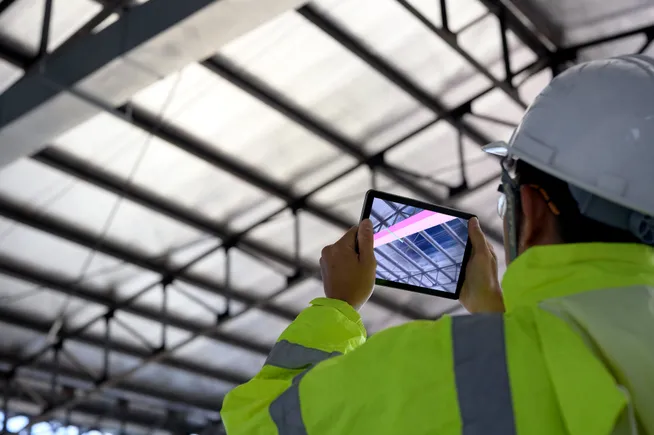3 business-essential areas where civil and infrastructure firms can lead with AI

The civil and infrastructure (C&I) industry is on the verge of a digital transformation, and AI-driven technologies are paving the way. While widespread adoption is still far off, a recent Procore survey found that “pockets of innovation” are emerging among progressive organizations. These companies are eager to harness the process automation, data analysis and productivity gains that AI promises.
But those companies are in the minority. Industry pros say AI-driven technology depends on having clean, robust datasets before analyzing information and making actionable solutions. Not all C&I firms are there yet. But if yours is heading toward AI adoption, here’s what you need to know about the capabilities this tech offers – and what your team needs to do to make it possible.
AI and job site safety: A growing opportunity
One of the most promising applications of AI in the C&I industry is job site safety. AI-powered machine vision and remote sensing technologies provide a bird’s-eye view of worksites, allowing for real-time monitoring and early warnings when people and equipment are at risk of colliding.
“The most interesting demo I’ve seen is using machine vision,” says Makenna Ryan, Solutions Engineer at Procore Technologies. “It’s essentially watching job sites from a near bird’s-eye view and looking for places where people and equipment may impact each other.” Having these automated eyes in the sky can supplement site safety managers’ ability to see the whole jobsite simultaneously. As AI tools help monitor the site, notifications and documentation for incidents or near-misses can be addressed quickly and cataloged efficiently.
Brian Saab, Head of Product, Resource & Asset Management for Procore agrees, noting that analyzing safety data is as important as collecting it. “Remote sensing and construction site observation can lead teams to identify emerging safety risks,” he says. “That might lead to training improvements, readiness improvements and an opportunity to train the team.”
Streamlining documentation with AI
AI is also simplifying the laborious task of documentation. For many firms, documentation is a critical yet time-consuming part of compliance, inspections and quality control. AI is helping streamline these processes by analyzing vast amounts of data and automating routine tasks.
Ryan shares a specific use case involving a bridge inspection team: “They took the AISC documentation for steel bridge inspection, loaded it into an AI tool, and used common language to come up with checklists that they needed to watch from a quality control perspective,” he says. From there, the team was able to tailor the checklist to their needs and enter it into Procore’s platform for reference and use by teams across the project.
Ryan says this particular user is among the “forward-thinking” portion of the industry that’s actively looking for ways to implement AI. “He used AI and extracted the information he needed to pay attention to, to make the most of their processes,” Ryan says. With AI’s speed and efficiency, these teams could move forward with bridge construction confidently and quickly.
Optimizing labor and equipment management with AI
Safety and documentation are both essential elements of a well-run C&I jobsite. However, making a business case for AI will require many owners to look for efficiencies that will truly save money. Labor and equipment management is an excellent place to focus that energy. With expensive equipment and stretched labor resources, firms must operate as efficiently as possible. Saab says AI can help in both cases.
“For equipment, those are very expensive machines, and they’re money-producing when they’re working, but they cost you money when they’re not working,” he says. “The telemetry baked into those machines leads to analysis around predictive maintenance schedules so you can understand if a machine is on the verge of having an issue that could cost you substantially.”
Ryan says these capabilities help firms optimize equipment usage and extend the lifespan of their assets – but the optimizations don’t stop there. AI also plays a role in optimizing labor by allowing companies to look at labor schedules and track how their teams perform in real-time. “The lowest-hanging fruit for most companies is operational efficiency,” he says. “that’s where most of their money is made and lost, so that’s where their attention is.”
The many benefits of AI for C&I firms
These are just a few examples of how AI will ultimately benefit the C&I industry. According to Procore’s recent survey, companies are particularly interested in AI’s ability to:
- Improve operational efficiency
- Enhance decision-making
- Analyze project requirements
- Manage schedules
- Identify and mitigate risks
- Automate routine tasks
- Forecast production rates
But despite the growing excitement around AI, both Ryan and Saab stressed that having control over your firm’s data is essential for AI tools to succeed. Many companies still struggle with fragmented data stored in spreadsheets or siloed applications, limiting their ability to implement AI effectively.
Ryan advises firms to start by mapping out their data landscape. “Take a step back and understand what your people are doing with their time each week,” he says. “Where does that information live? If you can understand where data moves through your organization, you’ll see where your gaps are. For most clients, operational efficiency is where the most money is made and lost, so it’s often the best place to start.”
Saab adds, “You have to make sure that your data isn’t locked up in silos. It’s great that many firms are adopting new applications, but if you’ve ended up locking your data in those applications, you’ve just created new silos. You’re not taking that substantive step toward merging your data and allowing your organization to learn and react from that data.”
The path forward for growth-minded firms
While full-scale AI adoption may still be a way off for some firms, those who take steps toward better data management and explore AI-driven solutions will be better positioned for long-term success. As Saab pointed out, the labor shortage in construction means AI could help by “up-leveling” even novice workers, making them more effective on the job by providing real-time insights and automating repetitive tasks.
For companies looking to get started, Ryan recommends starting small: “Pick one problem AI can solve and show the win. This is how you can get the ball rolling and demonstrate to your team how AI can have a real impact.”




